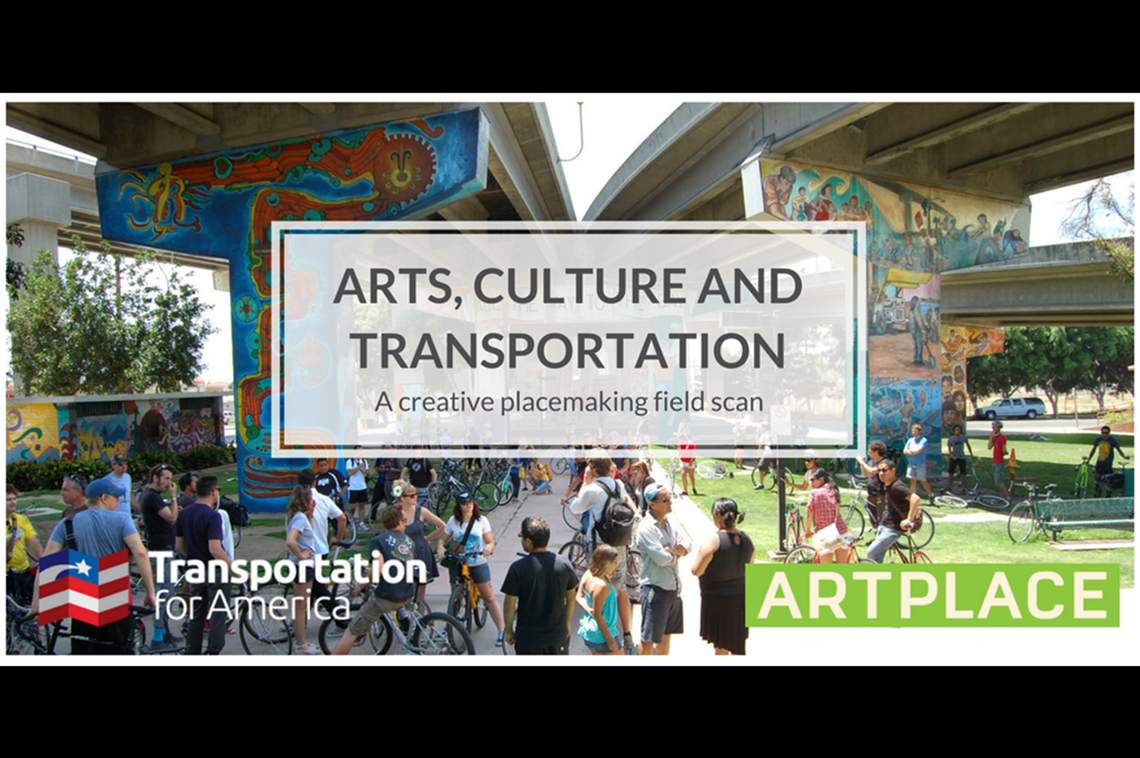
We’re thrilled to announce with our partners at Transportation for America the publication of our most recent field scan: Arts, Culture and Transportation: A Creative Placemaking Field Scan!
In looking at who does community planning and development in America’s communities, we have found that our colleagues are generally organized into ten sectors: Agriculture & Food, Economic Development, Education & Youth, Environment & Energy, Housing, Immigration, Public Safety, Transportation, and Workforce Development. As a core part of our research agenda, we are exploring how arts and cultural practitioners are and might become partners in helping to achieve each of these sector’s goals.
The publication released today is one of several “field scans” that ArtPlace America has commissioned to begin this work. This one, conducted and authored by Transportation for America, seeks to illuminate key priorities for the transportation sector and to provide a framework for understanding the ways that arts and culture can help achieve transportation-specific goals.
Transportation systems can and should be a powerful tool to help people access opportunity, drive economic development, improve health and safety, and build the civic and social capital that binds communities together. Unfortunately, a historic, top-down, technocratic approach to transportation planning and design has failed to achieve these goals for everyone. This has resulted in transportation systems that do not equitably serve communities of color, low-income people, and other disadvantaged communities.
But there’s reason for optimism.
Eager to find a better way, scores of communities are collaborating with artists for new, creative approaches to planning and building new projects and solving pressing transportation challenges. This process known as creative placemaking is unfolding in communities across the country and transportation professionals are eager to know: what are the key trends and best practices?
Arts, Culture and Transportation: A Creative Placemaking Field Scan is a rigorous national examination of creative placemaking in the transportation planning process. Released in partnership with T4A, this new resource identifies ways that transportation professionals can integrate artists to deliver transportation projects more smoothly, improve safety, and build community support.
This field scan is available via our friends at Transportation for America.
For a deep dive into Arts, Culture and Transportation: A Creative Placemaking Field Scan, register now for the live webinar discussion happening on October 13, 2017 from 1:00-2:00 pm EDT.
Two of our other field scans are below, and the next one on the environment is coming soon:
Exploring the Ways Arts and Culture Intersects with Public Safety: Identifying Current Practice and Opportunities for Further Inquiry
Caroline Ross, Urban Institute
Exploring the Ways Arts and Culture Intersects with Housing: Emerging Practices and Implications for Further Action
Danya Sherman, ArtPlace America
More about the Field Scans
Each field scan serves as a framing document for a working group tasked with taking the analysis and findings one step further, helping ArtPlace to identify the best practices that warrant formal case studies, key methods for evaluating success, and strategic framing of the material in a way that resonates with people most likely to take up creative placemaking practice in this sector. The field scan is not an end in itself, but an initial inquiry that, together with other field scans, will inform both ArtPlace’s work as well as those working at the intersection of art and community development more broadly.
Each field scan addresses two primary audiences: artists and other arts and cultural practitioners seeking to better understand and collaborate with a particular community development sector (in this case, the transportation sector); and community development practitioners who are interested in how arts and culture partners might further their work. Our ultimate goal is for these two audiences to develop a shared language and a set of mutual goals, so that communities will benefit from these powerful, cross-sector synergies.





